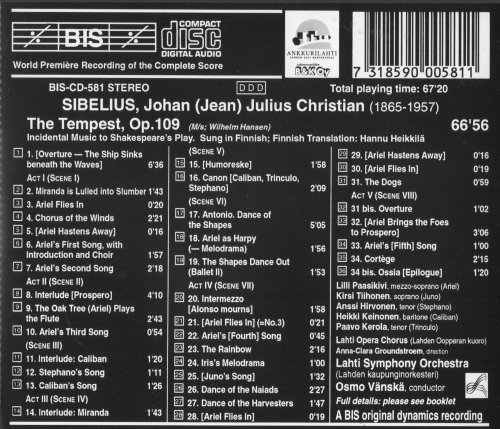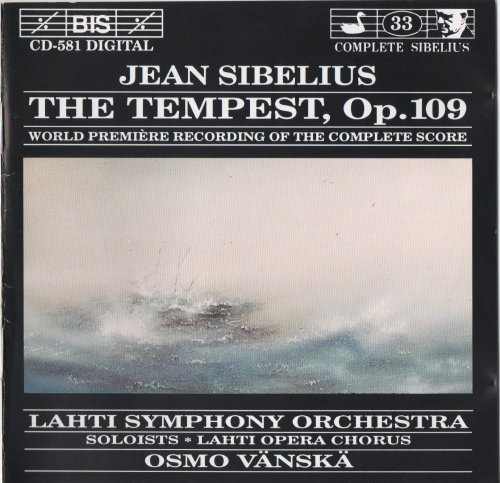
Lahti Symphony Orchestra, Osmo Vänskä - Jean Sibelius: The Tempest (1992)
BAND/ARTIST: Lahti Symphony Orchestra, Osmo Vänskä
- Title: Jean Sibelius: The Tempest
- Year Of Release: 1992
- Label: BIS
- Genre: Classical
- Quality: FLAC (image+.cue,log,scans)
- Total Time: 01:07:15
- Total Size: 274 Mb
- WebSite: Album Preview
Tracklist:
The Tempest, Op.109 (Incidental Music To Shakespearre's Play. Sung In Finnish)
1. [Overture — The Ship Sinks Beneath The Waves] Largamente Molto 6:36
Act I (Scene I)
2. Miranda Is Lulled Into Slumber (Harmonium, Harp) Andante 1:43
3. Ariel Flies In (Harp High Above The Stage) Allegro 0:20
4. Chorus Of The Winds (Chorus, Harmonium And Harp High Above The Stage) Molto Moderato 2:21
5. [Ariel Hastens Away] (Harp High Above The Stage) Allegro 0:16
6. Ariel's First Song, With Introduction And Choir "Hietikolle Käymme Näin"/'Come Unto These Yellow Sands' (Harmonium And Harp High Above The Stage) Poco Con Moto — Poco Tranquillo — Poco A Poco Stretto 1:57
7. Ariel's Second Song "Sun Isääs' Peittävät Synkeät Veet"/"Full Fadom Five Thy Father Lies' Largamente 2:18
Act II (Scene II)
8. Interlude [Prospero] Adagio — Poco Meno Adagio — Tempo Primo 4:10
9. The Oak Tree (Ariel) Plays The Flute (Flute Behind The Stage; Harp And Harmonium High Above The Stage) Molto Moderato 0:54
10. Ariel's Third Song "Täällä Senkun Kuorsataan"/'While You Here Do Snoring Lie' (Choir Behind The Stage) Moderato — Stringendo 0:54
(Scene III)
11. Interlude: Caliban. Allegretto — Più Moderato — Poco A Poco Stretto 1:20
12. Stephano's Song. Moderato — Commodo "En Enää Lähde Merelle"/'I Shall No More To Sea, To Sea' 1:11
13. Caliban's Song [Also Present: Stephano And Trinculo] "Hei, Prosperon Perkele"/'Farewell, Master; Farewell, Farewell!' Moderato — Allegro 1:26
Act III (Scene IV)
14. Interlude: Miranda. Allegretto 1:43
(Scene V)
15. [Humoreske] (Two Clarinets And Tambourine Behind The Stage; Harp High Above The Stage) Allegro Commodo 1:58
16. Canon [Caliban, Trinculo, Stephano] "Kurkitaan, Urkitaan"/'Flout'em And [S]cout'em' (Piccolo, Side-Drum, Glockenspiel, Harmonium, Harp Behind The Stage) 2:09
(Scene VI)
17. Antonio. Dance Of The Shapes. Moderato Assai — Allegro Molto Moderato — Poco Tranquillo — Allegro E Poco A Poco Stretto 5:05
18. Ariel As Harpy (— Melodrama) (Side-Drum, Harmonium And Harp High Above The Stage) Grave 1:56
19. The Shapes Dance Out (Ballet II) Allegro 1:53
Act IV (Scene VII)
20. Intermezzo [Alonso Mourns] Andante Con Moto 1:58
21. [Ariel Flies In] (=No.3) (Harp High Above The Stage) Allegro 0:21
22. Ariel's [Fourth] Song "Ennen Kuin Ehdit Huokaamaan"/'Before You Can Say "Come" And "Go"' Allegretto Moderato 0:45
23. The Rainbow. Poco Adagio 2:16
24. Iris's Melodrama. Moderato Assai 1:00
25. [Juno's Song] "Kunnia Ja Vaurautta"/'Honour, Riches, Marriage-Blessing' Commodo 1:32
26. Dance Of The Naiads. Allegretto Grazioso 2:27
27. Dance Of The Harvesters. Commodo 1:47
28. 28. [Ariel Flies In] (=No.3) (Harp High Above The Stage) Allegro 0:19
29. [Ariel Hastens Away] (=No.5) (Harp High Above The Stage) 0:16
30. [Ariel Flies In] (=No.3) (Harp High Above The Stage) Allegro 0:19
31. The Dogs. Poco Con Moto — Allegretto 0:59
Act V (Scene VIII)
32. Bis. Overture (=No.33. Ariel; [Oboe And Orchestra] Poco Con Moto 1:02
33. [Ariel Brings The Foes To Prospero] Largo — Un Pochettino Affrettando — Adagio 3:06
34. Ariel's [Fifth] Song (Same As No.31 Bis) "Mä Mettä Janooni Juoda Saan"/'Where The Bee Sucks, There Suck I' Poco Con Moto 1:00
35. Cortège. Tempo Giusto — P.a.p. Stretto 2:15
36. Bis. Ossia [Epilogue] Poco Adagio — Allargando 1:20
Performers:
Lilli Paasikivi - mezzosoprano
Kirsi Tihonen - soprano
Anssi Hirvonen - tenor
Heikki Keinonen - barytone
Paavo Kerola - tenor
Lahti Opera Chorus
Lahti Symphony Orchestra
Osmo Vänskä – conductor

The Tempest, Op.109 (Incidental Music To Shakespearre's Play. Sung In Finnish)
1. [Overture — The Ship Sinks Beneath The Waves] Largamente Molto 6:36
Act I (Scene I)
2. Miranda Is Lulled Into Slumber (Harmonium, Harp) Andante 1:43
3. Ariel Flies In (Harp High Above The Stage) Allegro 0:20
4. Chorus Of The Winds (Chorus, Harmonium And Harp High Above The Stage) Molto Moderato 2:21
5. [Ariel Hastens Away] (Harp High Above The Stage) Allegro 0:16
6. Ariel's First Song, With Introduction And Choir "Hietikolle Käymme Näin"/'Come Unto These Yellow Sands' (Harmonium And Harp High Above The Stage) Poco Con Moto — Poco Tranquillo — Poco A Poco Stretto 1:57
7. Ariel's Second Song "Sun Isääs' Peittävät Synkeät Veet"/"Full Fadom Five Thy Father Lies' Largamente 2:18
Act II (Scene II)
8. Interlude [Prospero] Adagio — Poco Meno Adagio — Tempo Primo 4:10
9. The Oak Tree (Ariel) Plays The Flute (Flute Behind The Stage; Harp And Harmonium High Above The Stage) Molto Moderato 0:54
10. Ariel's Third Song "Täällä Senkun Kuorsataan"/'While You Here Do Snoring Lie' (Choir Behind The Stage) Moderato — Stringendo 0:54
(Scene III)
11. Interlude: Caliban. Allegretto — Più Moderato — Poco A Poco Stretto 1:20
12. Stephano's Song. Moderato — Commodo "En Enää Lähde Merelle"/'I Shall No More To Sea, To Sea' 1:11
13. Caliban's Song [Also Present: Stephano And Trinculo] "Hei, Prosperon Perkele"/'Farewell, Master; Farewell, Farewell!' Moderato — Allegro 1:26
Act III (Scene IV)
14. Interlude: Miranda. Allegretto 1:43
(Scene V)
15. [Humoreske] (Two Clarinets And Tambourine Behind The Stage; Harp High Above The Stage) Allegro Commodo 1:58
16. Canon [Caliban, Trinculo, Stephano] "Kurkitaan, Urkitaan"/'Flout'em And [S]cout'em' (Piccolo, Side-Drum, Glockenspiel, Harmonium, Harp Behind The Stage) 2:09
(Scene VI)
17. Antonio. Dance Of The Shapes. Moderato Assai — Allegro Molto Moderato — Poco Tranquillo — Allegro E Poco A Poco Stretto 5:05
18. Ariel As Harpy (— Melodrama) (Side-Drum, Harmonium And Harp High Above The Stage) Grave 1:56
19. The Shapes Dance Out (Ballet II) Allegro 1:53
Act IV (Scene VII)
20. Intermezzo [Alonso Mourns] Andante Con Moto 1:58
21. [Ariel Flies In] (=No.3) (Harp High Above The Stage) Allegro 0:21
22. Ariel's [Fourth] Song "Ennen Kuin Ehdit Huokaamaan"/'Before You Can Say "Come" And "Go"' Allegretto Moderato 0:45
23. The Rainbow. Poco Adagio 2:16
24. Iris's Melodrama. Moderato Assai 1:00
25. [Juno's Song] "Kunnia Ja Vaurautta"/'Honour, Riches, Marriage-Blessing' Commodo 1:32
26. Dance Of The Naiads. Allegretto Grazioso 2:27
27. Dance Of The Harvesters. Commodo 1:47
28. 28. [Ariel Flies In] (=No.3) (Harp High Above The Stage) Allegro 0:19
29. [Ariel Hastens Away] (=No.5) (Harp High Above The Stage) 0:16
30. [Ariel Flies In] (=No.3) (Harp High Above The Stage) Allegro 0:19
31. The Dogs. Poco Con Moto — Allegretto 0:59
Act V (Scene VIII)
32. Bis. Overture (=No.33. Ariel; [Oboe And Orchestra] Poco Con Moto 1:02
33. [Ariel Brings The Foes To Prospero] Largo — Un Pochettino Affrettando — Adagio 3:06
34. Ariel's [Fifth] Song (Same As No.31 Bis) "Mä Mettä Janooni Juoda Saan"/'Where The Bee Sucks, There Suck I' Poco Con Moto 1:00
35. Cortège. Tempo Giusto — P.a.p. Stretto 2:15
36. Bis. Ossia [Epilogue] Poco Adagio — Allargando 1:20
Performers:
Lilli Paasikivi - mezzosoprano
Kirsi Tihonen - soprano
Anssi Hirvonen - tenor
Heikki Keinonen - barytone
Paavo Kerola - tenor
Lahti Opera Chorus
Lahti Symphony Orchestra
Osmo Vänskä – conductor
It seems that, in terms of his music, Jean Sibelius wanted to show a different face to Finland than the one seen by the rest of the world. Music that he produced for specific local occasions such as theatrical productions and cantatas for university graduations betray a mildly experimental bent that is analogous in painting to the work of an early Fauvist or, perhaps, Norwegian proto-modernist Edvard Munch. However, he did not allow these pieces written for Finnish audiences out of his cabinet, usually withholding publication of the originals in favor of heavily revised "suites" from same, or worse, destroying the scores. To the outside world, he wanted to be reckoned as a Romantic, and some writers have proclaimed Sibelius "The Last Romantic," notwithstanding the presence of Richard Strauss and the fact that the latter remained active in music long after "The Silence in Jarvenpäa" had commenced.
The traditional view of Sibelius as a holdout of Romanticism, and therefore, as a Germanic artist, is undergoing a serious revision now that Finnish labels such as BIS and Ondine are making available a fjord-full of revelations in the form of never-heard Sibelius scores in their unadulterated forms. These uncover Sibelius' instinctive, and pioneering, exploration of modernistic concepts in music. BIS' Jean Sibelius: The Tempest, Op. 109 is the last of Sibelius' 11 known scores for theatrical productions and was begun in 1924, but the first performance was delayed, mostly by Sibelius' storied inability to deliver a commission on time, until 1927. After extracting two typical suites from this enormous score, 34 movements long, and taming the music down, Sibelius filed the original away -- it was not heard again until 1992.
Jean Sibelius: The Tempest, Op. 109, consists of a recording made in conjunction with the first concert revival of the complete incidental score, a Sinfonia Lahti production piloted by Osmo Vänskä and featuring the estimable talents of mezzo-soprano Lilli Paasikivi in the important role of Ariel. The performance is terrific, and would be perfect excepting some matronly singing toward the end by Paasikivi, in itself not really that distracting considering what a beast of a work this must be to perform. The recording is state of the art, and it will truly raise the roof of one's home in loud passages even though it is just a standard CD in no special format. Nevertheless, the greatest thing about Jean Sibelius: The Tempest, Op. 109, is the work itself, revealing "warts and all" Sibelius at its best, with all its jagged edges, vacant-eyed anxiety, and foreboding white glaciers of sound intact.
The traditional view of Sibelius as a holdout of Romanticism, and therefore, as a Germanic artist, is undergoing a serious revision now that Finnish labels such as BIS and Ondine are making available a fjord-full of revelations in the form of never-heard Sibelius scores in their unadulterated forms. These uncover Sibelius' instinctive, and pioneering, exploration of modernistic concepts in music. BIS' Jean Sibelius: The Tempest, Op. 109 is the last of Sibelius' 11 known scores for theatrical productions and was begun in 1924, but the first performance was delayed, mostly by Sibelius' storied inability to deliver a commission on time, until 1927. After extracting two typical suites from this enormous score, 34 movements long, and taming the music down, Sibelius filed the original away -- it was not heard again until 1992.
Jean Sibelius: The Tempest, Op. 109, consists of a recording made in conjunction with the first concert revival of the complete incidental score, a Sinfonia Lahti production piloted by Osmo Vänskä and featuring the estimable talents of mezzo-soprano Lilli Paasikivi in the important role of Ariel. The performance is terrific, and would be perfect excepting some matronly singing toward the end by Paasikivi, in itself not really that distracting considering what a beast of a work this must be to perform. The recording is state of the art, and it will truly raise the roof of one's home in loud passages even though it is just a standard CD in no special format. Nevertheless, the greatest thing about Jean Sibelius: The Tempest, Op. 109, is the work itself, revealing "warts and all" Sibelius at its best, with all its jagged edges, vacant-eyed anxiety, and foreboding white glaciers of sound intact.

Classical | FLAC / APE | CD-Rip
As a ISRA.CLOUD's PREMIUM member you will have the following benefits:
- Unlimited high speed downloads
- Download directly without waiting time
- Unlimited parallel downloads
- Support for download accelerators
- No advertising
- Resume broken downloads


